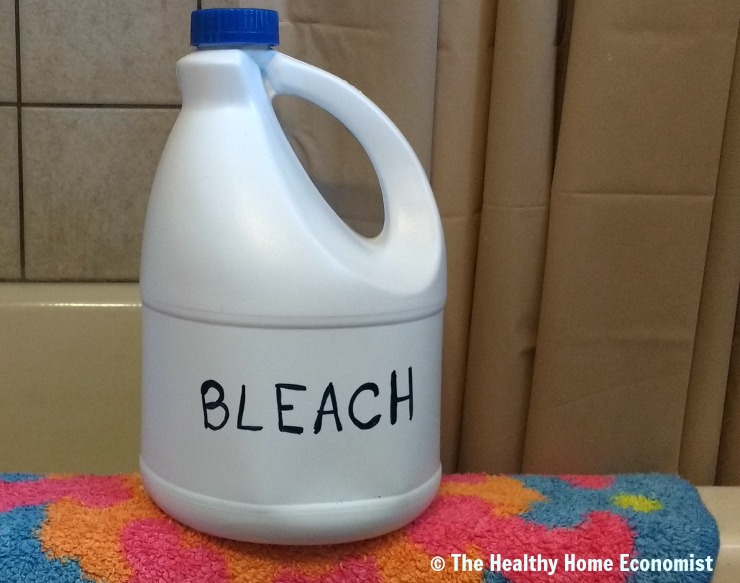
The old fashioned bleach bath is making a strong comeback in our modern, auto-immune compromised world. This country doctor solution was commonly recommended in generations past for acute, one-off skin infections that were not of a persistent nature.
And it worked – really, really well.
The difference today is that the bleach bath is being recommended by infectious disease doctors for long-lasting skin problems in patients who are experiencing chronic issues related to eczema or the superbug MRSA. You have to wonder if bleach will be recommended for C. Auris infections too. This latest superbug, a fatal fungus, is resistant to all 3 classes of anti-fungal drugs.
Unfortunately, the suggestion to soak in a tubful of water with a small amount of chlorine bleach added is misguided for these types of skin conditions and can ultimately make these situations worse over time.
Before identifying the health risks of a bleach bath and why it probably won’t work long term for MRSA or eczema in most cases, let’s first talk about the specifics of a chlorine bath.
What is a Chlorine Bleach Bath?
The common directive for a “therapeutic” bleach bath (not to be confused with a hydrogen peroxide bath) is as follows:
- Fill a standard size bathtub with warm water to the overflow drainage level.
- Pour 4 oz (118 ml) of chlorine bleach into the filled tub.
- Soak the entire body (from the neck down) or affected areas only (such as the legs) for 10 minutes.
- Rinse off with warm water and quickly dry with a towel to avoid chills.
The premise behind the bleach bath recommendation is that the chlorine is a very effective sanitizer. No argument there! Chlorine does kill the bacteria associated with all types of skin infections including the staph from eczema lesions or MRSA, the mutated superbug with the scary-sounding name Methicillin-resistant Staphylococcus aureus.
Bleach Baths: A Band-Aid Approach
While it may sound harmless enough at first, unfortunately for most people, embracing chlorine baths as the long-term solution to their chronic skin problems won’t prove to be a lasting solution at all. In no way is a bleach bath related or similar to the benefits achieved from a detoxification bath.
According to Carrie Perez, MRSA expert and founder of MRSASupportGroup,
During my initial research [on MRSA], I found another mom with a similar situation as my own (she and her daughter were both getting MRSA infections) and she explained to me how great they were doing. They had been taking bleach baths a few times per week and washing all their linens daily. Now, they only got infected every three months (instead of every month). She considered that success, but it didn’t sound like an acceptable solution to me.
Insightful observation!
What this woman endorsing the benefits of bleach baths is describing sounds more like a band-aid approach to resigning oneself with living with MRSA and managing the situation so it is bearable rather than an actual long-term solution to eliminating MRSA infections for good.
What about a bleach bath to eliminate the itch and discomfort of eczema? Here’s what Jennifer Roberge, founder of The Eczema Company has to say:
While bleach does kill bacteria like staph that can trigger infections in those with eczema, it is a very harsh chemical and can severely dry out the skin ultimately making things worse!
The Real Problem with a Bleach Bath
The basic issue with a bleach bath for chronic skin ailments is that you are trading one problem for another: pathogenic bacteria for a toxic chemical.
Talk about picking your poison!
People seem to forget that chlorine is an extremely toxic chemical and one that very effectively destroys beneficial gut flora whether it ingested via chlorinated tap water (hopefully you have a whole house water filter), absorbed into the bloodstream through the skin during a bleach bath (or even a regular bath in chlorinated tap water), or inhaled as toxic chlorine fumes during a shower.
Here’s the kicker.
Ultimately, it is a severely unbalanced gut environment with insufficient populations of beneficial microbes that are causing the eczema problems and/or MRSA infections in the first place!
Embracing the practice of bleach baths, while it may provide welcome relief in the short term, is ultimately going to make the problem worse by further decimating friendly bacteria in the gut and on the skin. The bleach dries out the skin terribly too, which negatively affects the pH. This is the perfect storm that provides free rein to pathogenic bacteria to entrench and thrive even more causing further skin irritation and infection.
What About Chlorinated Pools Instead of Bleach Baths?
For those that cannot tolerate bleach baths, frequent dips in swimming pools are sometimes suggested instead. But, this strategy has its own set of health dangers.
Like bleach baths, swimming in chlorinated pools results in inhalation of chlorine fumes and absorption of the chemical into the bloodstream via the skin, both of which harm beneficial gut flora. The inhalation problems are particularly problematic with indoor pools.
Michael Plewa, professor of genetics at the University of Illinois has found in his research that pool chemicals contribute to health problems such as asthma and bladder cancer. This is due not just to the chlorine, but more noxious agents created when pool disinfectants combine with organic matter in the pool water such as sweat, hair, and urine or nitrogen-rich substances found in personal care products.
Love swimming in chlorinated pools? Safe chlorinated pool swimming guidelines suggest doing so only occasionally, selecting outdoor pool locations, and rinsing off before entering the pool and immediately after swimming.
Certainly it’s not a good idea to consider frequent swims in chlorinated pools to resolve problems with eczema or MRSA infections.
Watch out for Vetericyn!
Lately, I have noticed emails and comments on this blog singing the praises of vetericyn in combating MRSA infections or other staph infections of the skin.
Vetericyn is a family of animal wound and skincare products. The FDA approved form of vetericyn for humans is called Puracyn Plus.
Unfortunately, while the manufacturer of vetericyn claims the product is totally nontoxic, pH balanced and safe, the active ingredient is hypochlorous acid, which is essentially a bleach bath in a bottle! This is because hypochlorous acid is formed when chlorine dissolves in water.
Don’t be fooled by vetericyn or products like it such as Hibiclens, a chemical disinfectant also recommended for bathing purposes by infectious disease physicians. Ultimately, these products are only addressing the topical symptoms of MRSA and eczema, not the internal root causes.
The Solution to Chronic Skin Infections is not Bleach
The bottom line is that adopting the practice of a bleach bath on a repetitive basis to address chronic issues with MRSA or eczema ultimately will not solve where the infections are coming from in the first place. The skin infections of today are much hardier, stronger, and scarier (as in mutated) than in days of old when one or two bleach baths would clear up a simple, one-time bacterial skin infection and that would be that.
There are many things that can kill MRSA and other bacterial nasties on a topical basis. However, this is not where the health problem is ultimately rooted. Chronic, recurrent issues with MRSA and eczema stem from internal, whole-body issues rooted in gut imbalance (2).
For example, Vetericyn might be fine for infection prevention for cuts and wounds (surgical/hospital use) or very superficial MRSA infections that won’t recur. However, for chronic, entrenched skin problems that don’t heal with conventional methods, non-chemical, holistic approaches such as allicin, silver, oregano oil (brand), activated charcoal (AC), and others are far more effective depending on how the MRSA is manifesting and the location on the body.
For more information, the linked article outlines effective, nontoxic, dietary and supplement approaches for MRSA treatment. And, this linked article outlines doctor-approved, natural eczema remedies.
Skip the bleach bath!








Leave a Reply